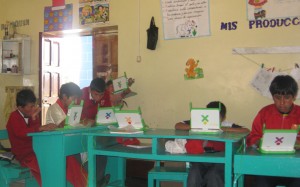They tell me that they were still using typewriters in Peru in the late 90s. (That was the year I set up my computer with Windows 98). Each student brought their own typewriter to school for typing class. A row of old men with typewriters competing for business in various parks around Lima were in charge of producing the city’s official contracts, letters and documents.

Even today, tech guys in Huancayo get a lot of work doing tipeos (type-ups). Sometimes, people pay just to get their documents typed out faster, but there are still many adults who don’t have any experience with computers at all. In 2007, the Peruvian Ministry of Education joined the “One Laptop per Child” (OLPC) campaign. I was first introduced to the infamous XO laptops when I visited a friend of mine in Miraflores, a rural village outside of Huancayo.

These were some of the arguments:
1. Teachers weren’t being trained. I noticed this in Miraflores. The task for computer class was to copy what the teacher had written on the board and if there were any software problems, the teacher asked some of the more computer-savvy children in the class. I liked how the children developed independent problem-solving skills.
2. Laptops take time away from playing outdoors. It’s a strange sight, seeing a child in the middle of rural farmland with his or her fancy new laptop. Some parents even encourage their children to use their laptops at home to keep them occupied. Though still a relatively new phenomenon, we’re starting to see the development of couch potato habits.
3. Children devalue their hometown. Owning a laptop can make these children feel more equal to children in the big cities, but it also means that many children lose appreciation for their own village or lose respect for their less-educated village elders. Migration out of the Andes has long been an issue in Peru, but we can’t stop children from dreaming big.
What are your thoughts? Do the advantages of the OLPC campaign seem to outweigh the disadvantages? Do you feel strongly about any of these arguments?
I’d also love to hear about your experiences with technology when you were younger. =)


